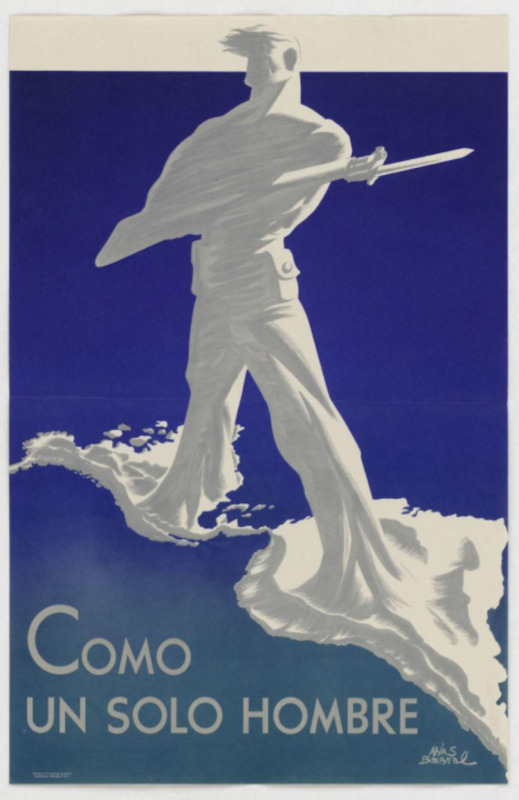Mexico Joins the War
In 1943, the US Office of the Coordinator of Inter-American Affairs commissioned Antonio Arias Bernal, a noted Mexican political cartoonist, to rally the support of the Mexican public behind the Allied Powers. This is one of several posters that Bernal created for the US government in the early 1940s, a time in which the US and Mexican government coordinated to wage a propaganda campaign to increase support for the Allied Powers within Mexico. The sentiment that the US and Mexico should fight “[As just one man]” is a far cry from the distrust and skepticism that had characterized the relationship between the two nations in the previous decade, demonstrated by the attitudes at the Evian Conference. This poster is one of many that seeks to encourage Mexican support for the war by highlighting American solidarity and Mexican traditions, while distracting from the dire situation of the Jews in Europe.
The central focus of the poster is a large statue of a masculine and powerful man, prominently standing on both North and South America. The man's presence, especially with his head extending over the blue border, signifies strength, authority, and dominance. The position of the man, with each leg solidly immersed in each continent, underscores the words’ goal to evoke a sense of unity and shared purpose. Furthermore, the portrayal of North America as relatively small and South America as larger in perspective can be seen as a deliberate artistic choice. This visual distortion emphasizes the importance of South America and its contribution to the war effort.
The hyper-masculine features of the man is underscored by the gun that is pictured as part of his arms. The shape and style of the gun is significant, as it closely resembles the 1910 Mauser Carbines, the rifles primarily used by Mexican revolutionary war hero Pancho Villa and his men (Schuler 110). This evokes nationalist sentiments among a Mexican audience, drawing on the history of resistance and struggle for independence. The call to the revolutionary era not only distracts from the Jewish refugee crisis, but also implicitly reinforces Mestizaje by situating the Mexican people in the time in which the Mexican state first articulated the idea, celebrating Mestizo culture.
The propaganda campaign coordinated by both the US and Mexican governments throughout the early 1940s is representative of the major shift in the relationship between Mexico and the United States that occurred under Mexican President Ávila Camacho’s regime. During his term relations between Mexico and the United States were strained at first, as in the previous decades, but the initial tension gave way to a more open cooperation, based on a diplomatic rapprochement that focused on building an American bloc against the Nazi-Fascist axis. The conditions created by the war would lead the governments of Mexico and the United States to initiate a stage of open and formal cooperation, which had not been the practice before, and would result in a strong concentration of economic ties between Mexico and the US, (Schuler 112). As we will see, this newfound relationship between the two nations would permeate official policy as well as public opinion in regards to Jewish immigration.
This section examines Mexican policy toward Jewish refugees during the years in which the Nazis decided to implement the so-called Final Solution: the methodical and systematic extermination of the entire European Jewish population, (Schuler 112). Analysis of a series of war posters produced by both the US and Mexican governments reveals an emphasis on Mexican history and traditions, American solidarity, and industrial production that distracted from the escalating danger that threatened the Jewish community. Therefore, while Mexico joining World War II prompted a shift in the state’s official policy as well as public opinion that was anti-Fascist and sympathetic to victims of Fascist persecution, little attention was paid in Mexico to the impact of the war on Jewish people in Europe, and the nationalist themes that the government centered at the forefront of the Allies’ cause reinforced the Mestizaje ideals that governed Mexican immigration policy in the previous administrations. Thus, despite the increase in urgency for Jewish refuge from 1942 through 1945, Mestizaje continued to dominate Mexican immigration policy and very few Jewish refugees were allowed into Mexico.
